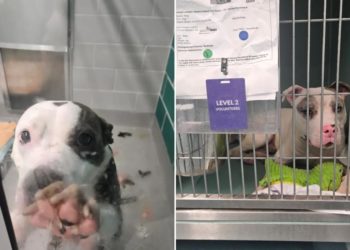On Monday, the Washington police union was decrying President Trump’s use of pardons when he let off rioters who attacked more than 150 officers on Jan. 6, 2021. By Wednesday, the same union was praising Mr. Trump after he pardoned two of their own who had been convicted in connection with the death of a young Black man.
With his flurry of pardons this week, Mr. Trump sent contradictory messages about his support for police. He showed he would support them in many situations, even when prosecutors and juries say they have gone too far. But his decision-making appeared centered less on “backing the blue” than on whether those in blue backed him.
Mr. Trump made this clear when he used his clemency power to wipe clean the records of around 1,600 Jan. 6 defendants, including those who had used stun guns and chemical spray on police officers. A day later, he teased that he would soon issue clemency to help police officers convicted after a chase that killed a 20-year-old Black man, Karon Hylton-Brown, in 2020. Mr. Hylton-Brown’s death — and a coverup by the police — led to protests in the nation’s capital.
To some degree, the one-two punch of decisions was typical politics. Mr. Trump’s pardons angered a constituency he prizes, so he followed up with a move meant to appease police. But some saw a distinct racial dynamic at play, with the president siding with a largely white mob on Jan. 6 and with white police officers in Mr. Hylton-Brown’s killing.
David L. Shurtz, a lawyer for Mr. Hylton-Brown’s family, said he “absolutely” believed race had played a role in the pardons.
Amaala Jones-Bey, the mother of Mr. Hylton-Brown’s 4-year-old daughter, said the contradictions in Mr. Trump’s decisions on pardons were baffling. “You just pardoned people who caused harm to your police officers but now he’s pardoning police officers who harmed citizens,” she said.
Wednesday was not the first time Mr. Trump has backed military or law enforcement officers accused of breaking the law. During his first term, he granted clemency to U.S. military officers who had been convicted or accused of war crimes in Iraq and Afghanistan.
Throughout his time in office, Mr. Trump often used his pardon power to benefit friends and allies, something other presidents have done as well.
But at no time was that impulse as clear or as wide-ranging than when he granted clemency to nearly 1,600 people arrested in connection with the Jan. 6 attack. Many of the rioters wore Make America Great Again hats, and, at one point, they even took down an American flag flying at the Capitol to replace it with a Trump flag — a symbol their loyalty was to a man, not to the nation.
Police unions are another area of support for Mr. Trump, including the National Fraternal Order of Police, which endorsed his campaign but condemned the pardon of the Jan. 6 rioters.
Even in condemning the Jan. 6 pardons, though, the Washington police union continued to advocate clemency for Officer Terence Sutton and Lt. Andrew Zabavsky of the Metropolitan Police Department, the men convicted in the case of Mr. Hylton-Brown. The union had argued that the men were victims of overzealous prosecutors who had criminalized actions that could have been addressed with training.
In announcing that he planned to issue clemency in the case, Mr. Trump mangled the facts and accused Mr. Hylton-Brown, an American citizen, of being an “illegal.”
“It just shows who has the power here in America,” Ms. Jones-Bey said. “I also feel a little shaken because if he thinks he’s an illegal citizen, where is he getting his information from? Is he actually paying attention?”
Mr. Sutton had been sentenced to more than five years in prison for second-degree murder and obstruction of justice in the unauthorized pursuit. Mr. Zabavsky was sentenced to four years in prison for conspiring with Mr. Sutton to cover up the deadly police chase. The two had been free pending the outcome of their appeals.
The Washington police union celebrated the clemency, praising Mr. Trump for carrying out an “monumental correction” of what it called an “injustice.”
Gil Kerlikowske, a former police chief in Seattle and three other cities, said he believed Mr. Trump’s pardoning of the two D.C. police officers was an attempt to restore his relationship with the police after the Jan. 6 pardons.
But he said he believed the decision to pardon Jan. 6 rioters would be remembered in the law enforcement community, in part because the video footage of the day is readily available.
“They say it’s all in the past,” Mr. Kerlikowske said. “With all the videos, clearly it’s not in the past. You can relive this.”
Officer Daniel Hodges, who defended the Capitol on Jan. 6, 2021, said he agreed with Mr. Trump’s pardons in the case of Mr. Sutton and Mr. Zabavsky. But he cautioned against viewing Mr. Trump as a friend of law enforcement.
“He really isn’t a friend of police,” he said. “He’s a friend of people who flatter him.”
Mr. Hodges has been outspoken about the display of racism he saw on Jan. 6, and famously said at the time that it had been his “pleasure to crush a white nationalist insurrection.”
But four years later, Mr. Trump has returned to Washington victorious, and Officer Hodges was assigned to work the inauguration, protecting the president.
“It’s what the people voted for,” he said of Mr. Trump’s inauguration. “So it’s my job to make sure that it happens peacefully and securely. I’m not going to let my personal feelings influence how I perform my job.”
The post Trump Supports the Police, Just as Long as They Support Him appeared first on New York Times.




